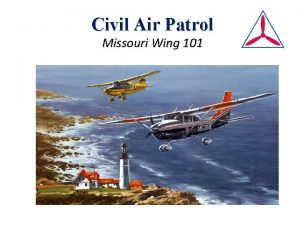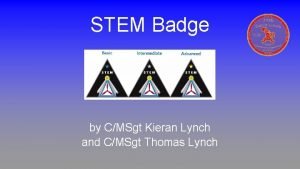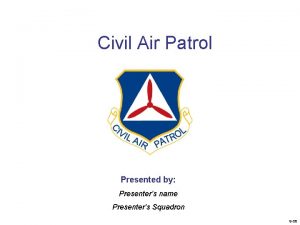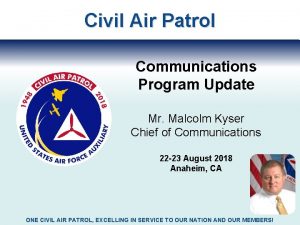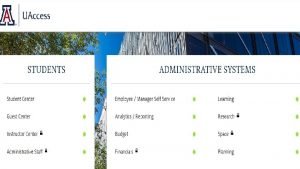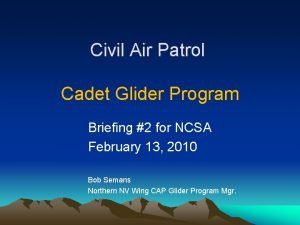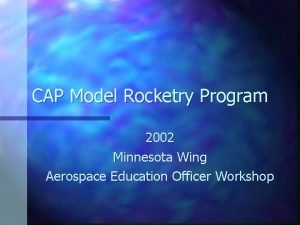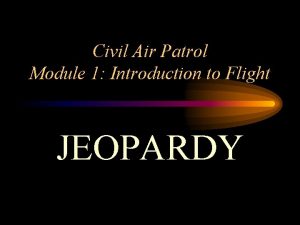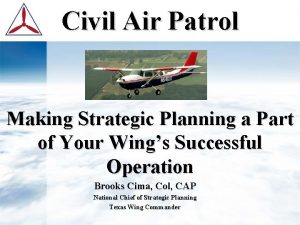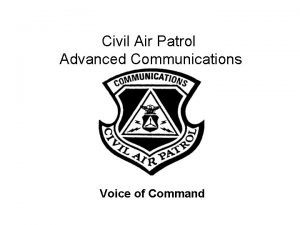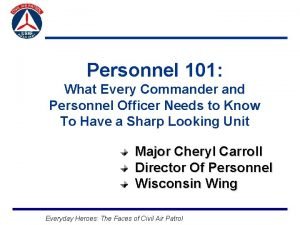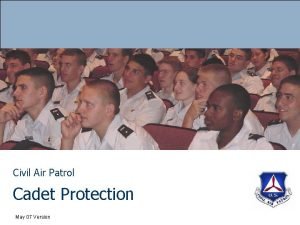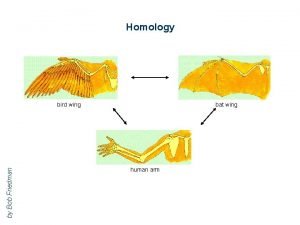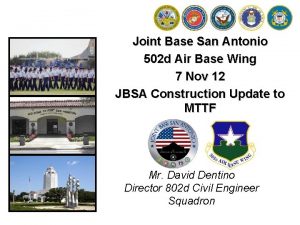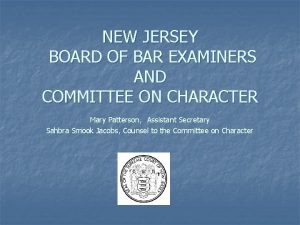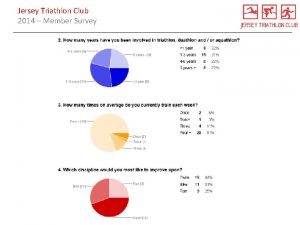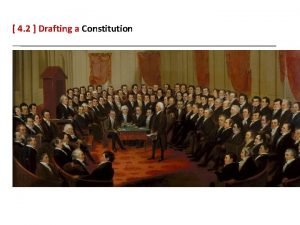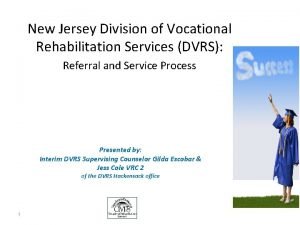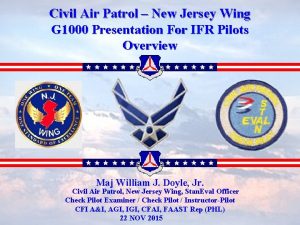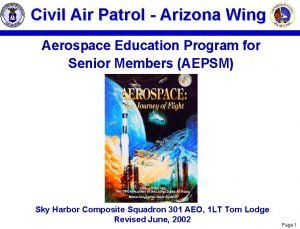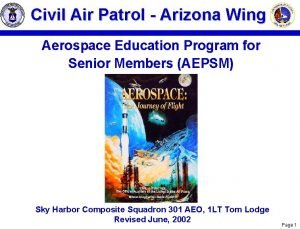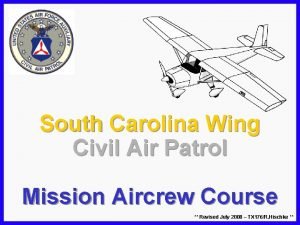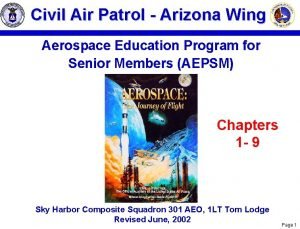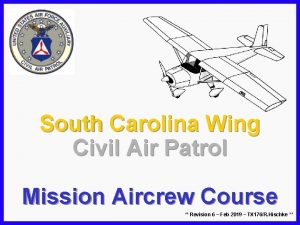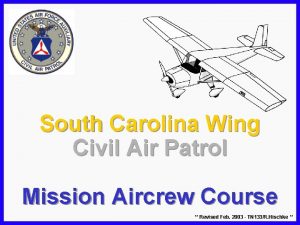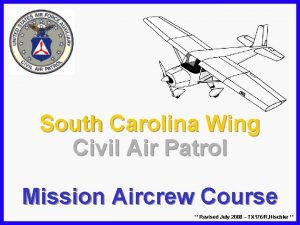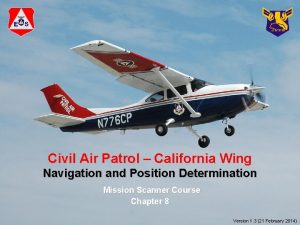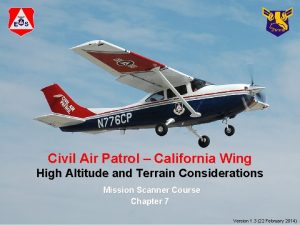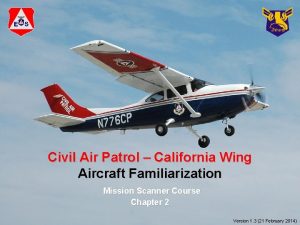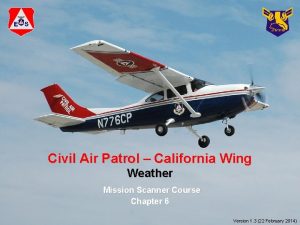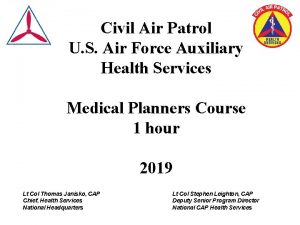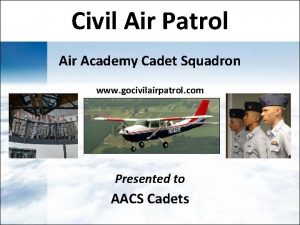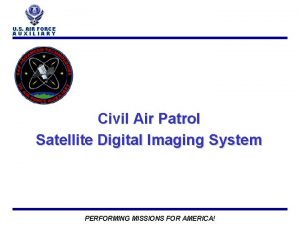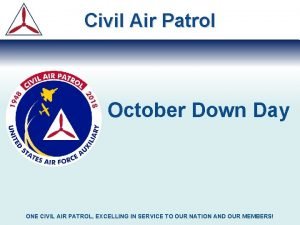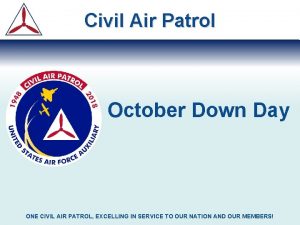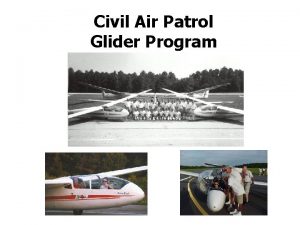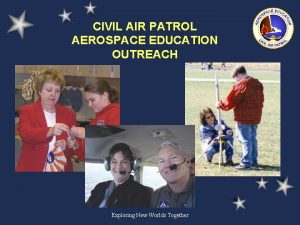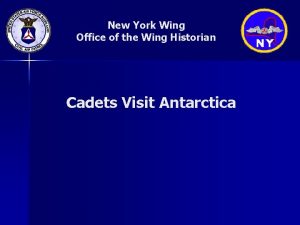Civil Air Patrol New Jersey Wing 2014 G

















































- Slides: 49

Civil Air Patrol – New Jersey Wing 2014 G 1000 Presentation For CPEs, CPs, and IPs Maj William J. Doyle, Jr. Civil Air Patrol, New Jersey Wing, Stan. Eval Officer Check Pilot Examiner / Check Pilot / Instructor-Pilot CFI A&I, AGI, IGI, CFAI, FAAST Rep (PHL) 23 SEP 2014

Presentation Overview • What this presentation is – This presentation is an overview of the CAP NHQ 2013 G 1000 Ground School for Check Pilot Examiners, Check Pilots, and Instructor Pilots – This presentation illustrates and highlights what Check Pilot Examiners, Check Pilots, and Instructor Pilots should do to prepare for the G 1000 Instructor Ground School – This presentation is a guide for what Check Pilot Examiners, Check Pilots, and Instructor Pilots should be teaching when they give CAP pilots ground and flight instruction in the G 1000 • What this presentation is not – This presentation is not an online version of the NHQ G 1000 Course – This presentation is not a guide of how to use the G 1000

Overview of CAP G 1000 Instructor Ground Course

Instructor Ground Course – Training Matrix

Preparation for Instruction • NHQ Training Philosophy – Minimize risks associated with over-dependency on automation – Emphasize “eyes outside the cockpit” and “hands-on” flying skills • Overview of Horizontal Situation Indicators (HSIs) – Many CAP pilots are unfamiliar with the HSI. • Bendix-King HSI Tutorial #49 • Bendix-King HSI Tutorial #66 • Century NSD 1000 HSI 68 S 85 • Wikipedia Horizontal Situation Indicator • Overview of Technologically Advanced Aircraft (TAAs) – The links below are to FAA Safety Seminars on TAAs and GPS • http: //williamjdoylejr. net/FAAST/TAA. ppt • http: //williamjdoylejr. net/FAAST/gps. ppt

Overview of Instructor Ground Course • Course Overview – This G 1000 Instructor Ground Course is not about how to use the G 1000 – This G 1000 Instructor Ground Course is about how to teach the G 1000 – NHQ intends that all ground instruction will be face-to-face – The VFR G 1000 Ground Course would be a full day course – The IFR G 1000 Ground Course would be a full day course • Instructor Ground Course and Flight Scenarios – Instructor Ground Course – 42 slides – Instructor Flight Scenarios

Overview of Instructor Ground Course • Instructor and Pilot Resources – G 1000 Information – Ground School Study Guide – Version 10 a – N 355 CP – N 941 CP – CAPR 60 -1 – see text in yellow highlights for G 1000 changes – CAPF-5 (Word) – new version effective APR 2014 – CAPF-5 (PDF) – new version effective APR 2014 – Garmin G 1000 PC Trainer for Cessna NAV III, Version 12. 0 • Good investment, buy it for yourself, urge your students to do the same • $24. 95 plus $8. 00 shipping • https: //buy. garmin. com/shop. do? p. ID=113763

Overview of Instructor Ground Course • CAP G 1000 Endorsements – Consider example of a Wing with Cessna 182 T and Cessna U 206 H, both equipped with the Cessna Nav III G 1000 System • This may seem hypothetical but it is the case in PAWG – Consider a pilot who was already “Form 5 -ed” in the Cessna 182 T and in a Cessna U 206 G (round dial, steam gauge, Six Pack) – Under the old rules the pilot would have had to take an additional CAPF-5 check ride in the Cessna U 206 H Nav III since it was different from the Cessna U 206 G. – Under the new rules the pilot’s CAPF-5 G 1000 endorsement taken for the Cessna 182 T and the pilot’s CAPF-5 in the Cessna U 206 G would cover the pilot to fly the Cessna U 206 H without having to take an additional CAPF-5 check ride.

Overview of Instructor Ground Course • CAP G 1000 Endorsements – Consider example of a unit with Cessna 182 T and Cessna 172 S, both equipped with the Cessna Nav III G 1000 System • This may seem hypothetical but my flying club at Doylestown Airport actually has two such airplanes – Consider a pilot who was already “Form 5 -ed” in the Cessna 182 T and in a Cessna 172 P (round dial, steam gauge, Six Pack) – Under the old rules the pilot would have had to take an additional CAPF-5 check ride in the Cessna 172 S Nav III since it was different from the Cessna 172 P. – Under the new rules the pilot’s CAPF-5 G 1000 endorsement taken for the Cessna 182 T and the pilot’s CAPF-5 in the Cessna 172 P would cover the pilot to fly the Cessna 172 S without having to take an additional CAPF-5 check ride.

Overview of Instructor Ground Course • CAPF-5 Flight Evaluation Form – April 2014 – CAPF-5 Word document – CAPF-5 Adobe PDF • Top portion shown below

What is CFIT? Controlled Flight into Terrain

Anything Wrong With This Picture?

What About This Picture?

So What Do You Think? CFIT in the Making?

CAP CFIT Accident Las Vegas, NV 8 NOV 2007

Night VMC Takeoff Accident in T 182 T G 1000 - CFIT • Controlled Flight into Terrain (CFIT) with two fatalities – N 881 CP – NTSB Factual Report – click link below http: //www. ntsb. gov/aviationquery/Gen. PDF. aspx? id=SEA 08 FA 023&rpt =fa – NTSB Probable Cause – click link below http: //www. ntsb. gov/aviationquery/brief. aspx? ev_id=20071121 X 01832 &key=1 – Crew Experience and FAA Certificates • Pilot (left seat): – ATP AMEL, Commercial ASEL, 25, 000 hours total time, G 1000 trained (74. 7 hours G 1000, 34. 2 hours in accident airplane) • Pilot (right seat): – ATP AMEL, helicopter, CFI, AGI, IGI, 28, 000 hours total time, not G 1000 trained

Night VMC Takeoff Accident in T 182 T G 1000 - CFIT • Controlled Flight into Terrain (CFIT) with two fatalities – N 881 CP – Events from night of 11/08/2007 • Departed North Las Vegas Airport (VGT), Las Vegas, NV on a VFR flight plan about 19: 05 Local PST bound for Rosamond Skypark Airport (L 00), Rosamond, California • 19: 05: 29 Local PST - checked in with ATC at 2, 700 feet MSL • 19: 17: 29 Local PST - radar contact lost, airplane impacted 1, 000 feet below summit of Mt. Potosi (elevation = 8, 514 feet MSL) • Fireball from impact witnessed by law enforcement helicopter – Interviews with the ATC Controller produced the following • Controller stated, "The aircraft looked fine - there was nothing unusual about it. ” • When questioned about where he expected the aircraft to go the controller replied that “. . . the pilot was on his own navigation. ” • Controller stated that other aircraft he has seen go where the accident aircraft was, and some go further south. • Asked when he is required to issue a safety alert, the controller stated, in his opinion, when an aircraft is close to terrain or other aircraft.

Night VMC Takeoff Accident in T 182 T G 1000 - CFIT • Controlled Flight into Terrain (CFIT) with two fatalities – N 881 CP – Conditions of Flight • Accident occurred during dark night under visual meteorological conditions. • No lighted roads or round structures were present in the area to provide ground reference to terrain. • 1% of the moon’s disk was illuminated. – Airplane climb performance over last six minutes of flight per recorded radar data • Average groundspeed was 100 knots • Average rate of climb was 406 fpm (feet per minute) • Note: an average rate of climb of 600 fpm was required to clear terrain along the flight path.

Night VMC Takeoff Accident in T 182 T G 1000 - CFIT • Controlled Flight into Terrain (CFIT) with two fatalities – N 881 CP – NTSB Findings 1. 2. 3. 4. 5. (F) TERRAIN CONDITION - RISING (F) TERRAIN CONDITION - MOUNTAINOUS/HILLY (F) LIGHT CONDITION - DARK NIGHT (C) ALTITUDE/CLEARANCE - NOT MAINTAINED - PILOT IN COMMAND (F) OTHER PSYCHOLOGICAL CONDITION - PILOT IN COMMAND a) Ethanol b) Diphenhydramine (Benadryl) 6. (F) PROCEDURES/DIRECTIVES - NOT FOLLOWED - ATC PERSONNEL (ARTCC) 7. (F) SAFETY ADVISORY - NOT ISSUED - ATC PERSONNEL (ARTCC) – Legend • (F) – Factor • (C) – Cause

Night VMC Takeoff Accident in T 182 T G 1000 - CFIT • Controlled Flight into Terrain (CFIT) with two fatalities – N 881 CP – Lessons Learned • Know necessary climb out rate – Conversion formula for Feet Per NM to Feet Per Minute (FPM) • Feet Per NM / feet in NM * 100 * ground speed (per G 1000) – VGT Northtown Three Departure from Runway 30 L uses 415 feet per NM • 415 / 6076 * 100 = 683 FPM – VGT Boulder City One Departure from Runway 30 L uses 367 feet per NM • 367 / 6076 * 100 = 604 FPM • Do not depend on ATC for terrain separation • File for an instrument departure • Know the airplane’s equipment – See G 1000 illustration on terrain avoidance

Night VMC Takeoff Accident in T 182 T G 1000 - CFIT • Controlled Flight into Terrain (CFIT) with two fatalities – N 881 CP – G 1000 illustration on terrain avoidance • PDF inset or MFD – Red – 100 feet AGL or less – Yellow – more than 100 feet AGL but less than 1000 feet AGL – Black – 1000 feet AGL or higher

Overview of CAP G 1000 VFR Pilot Ground Course

Overview of G 1000 VFR Pilot Ground Course • Ground Course Modules – There are two ground course modules • VFR Ground Module #1 - Knobology and Stick & Rudder – 95 slides • VFR Ground Module #2 - Auto Pilot – 60 slides • Request form for ground training - NJWF-61 -1 G 1000 Ground Training Form – Form created by Maj Tom Woods • Flight Training Modules – There are two flight training modules • VFR Flight Scenario #1 • VFR Flight Scenario #2 • Request form for flight training - NJWF-61 -2 G 1000 Flight Training Form – Form created by Maj Tom Woods

Overview of G 1000 VFR Pilot Ground Course • Recommend that classes be segregated between KAP 140 Autopilot (N 355 CP) and GFC 700 (N 941 CP) – The links below are to Cessna Power. Point presentations for the KAP 140 Autopilot and the GFC 700 Integrated Flight Control System • KAP 140 Autopilot (N 355 CP) • GFC 700 (N 941 CP)

Overview of G 1000 Module #1 VFR Ground Course • G 1000 Components – PFD: AHRS, ADC, Magnetometer, GTX – MFD: EIU, Moving maps, GPS check (AUX) – GDU 1040 vs. GDU 1044 • Tuning Area – use right hand • Soft Keys – PFD Insert: Topo vs. Terrain • H. S. I. , Bearings, CDI colors • CAP Audio • MFD: Chapter / Page organization – EIU – Fuel indicators (35 gallons) – MAP – Latitude/Longitude; User waypoints – TIS, Stormscope, Nex. Rad (TFR indicators) – NRST Airports, Intersections, NDB, VOR, User WPT, Frequencies, Airspace – System Annunciators – Fuel – (slide on old version of fuel system is wrong) – Electrical System, Vacuum System – KOEL

Instructor Ground Course – VFR #1 Flight Syllabus

Instructor Ground Course – VFR #1 Flight Syllabus

Overview of G 1000 Module #2 VFR Ground Course • GFC 700 – FD vs. AP – who provides the muscle? – Modes • White = Armed • Green = Engaged • KAP 140 Autopilot – Note UP / DN buttons, effect of hold then release – ROL, HDG, NAV, APR; no yaw – GDU 1040 vs. GDU 1044 • CWS • Go Around button

Instructor Ground Course – VFR #2 Flight Syllabus

Instructor Ground Course – VFR #2 Flight Syllabus

Overview of CAP G 1000 IFR Pilot Ground Course

Overview of G 1000 IFR Pilot Ground Course • Ground Course Modules – There are two ground course module • IFR Ground Module #3 - Knobology and Stick & Rudder – 99 slides • IFR Ground Module #4 - Auto Pilot – 153 slides • Request form for ground training - NJWF-61 -1 G 1000 Ground Training Form – Form created by Maj Tom Woods • Flight Training Modules – There are two flight training modules. • IFR Flight Scenario #1 • IFR Flight Scenario #2 • Request form for flight training - NJWF-61 -2 G 1000 Flight Training Form – Form created by Maj Tom Woods

Overview of G 1000 IFR Pilot Ground Course • Recommend that classes be segregated between KAP 140 Autopilot (N 355 CP) and GFC 700 (N 941 CP) – The links below are to Cessna Power. Point presentations for the KAP 140 Autopilot and the GFC 700 Integrated Flight Control System • KAP 140 Autopilot (N 355 CP) • GFC 700 (N 941 CP)

Overview of G 1000 Module #3 IFR Ground Course • Flight Plan – Victor Airways – Preferred use – PFD vs. MFD: EIU, Moving maps, GPS check (AUX) – Direct To – given often by ATC for RNAV-equipped airplanes • Approaches – Approach plates – Enroute charts • SIDS and STARS • Holds – KAP 140 vs. GFC 700

Instructor Ground Course – IFR #1 Flight Syllabus

Instructor Ground Course – IFR #1 Flight Syllabus

Overview of G 1000 Module #4 IFR Ground Course • KAP 140 Autopilot – Note UP / DN buttons, effect of hold then release – ROL, HDG, NAV, APR; no yaw – GDU 1040 vs. GDU 1044 • GFC 700 – FD vs. AP – who provides the muscle? • GFC 700 – Approaches – Slide Notes – ILS/LOC Approaches – VOR Approaches – BC Approaches – RNAV GPS Approaches – Missed Approaches

Instructor Ground Course – IFR #2 Flight Syllabus

Instructor Ground Course – IFR #2 Flight Syllabus

What Are the Risks in Flying a Technologically Advanced Aircraft (TAA)?

What Are the Risks with Flying TAA? • Risk: Lack of Pilot Proficiency – Mitigation: study, study then practice, practice • Get the simulator for whatever GPS you have – Garmin GNS 430, Garmin GNS 530, Garmin G 1000 for Cessna NAV III, III Apollo GX 55 – See reference section for links • Download training videos, manuals (PDF), flight planning lessons • Get some ground instruction and flight instruction from your CFI

What Are the Risks with Flying TAA? • Risk: Head in the Cockpit Instead of Outside – Mitigation: Set up as much as possible on the ground • Do your flight planning at home before coming to the airport – File an FAA flight plan (consider filing IFR even if VMC) – Print a navigation log (consider AOPA Internet Flight Planner) • Set up flight plan in GPS after preflight and engine start but before taxi – Contact Clearance Delivery on radio or cell phone – Set up clearance route in your GPS

What Are the Risks with Flying TAA? • Risk: Single Pilot IFR – Mitigation: Take an experienced pilot or CFI • Establish personal minimums, don’t deviate from them – Consider establishing a risk management matrix – Refer to next section on personal minimums • Build experience – When appropriate, appropriate revise your personal minimums

What Are the Risks with Flying TAA? • Risk: Thunderstorm Penetration – Mitigation: Avoid thunderstorms • Do not use Nex. Rad or Strike Finder features to penetrate thunder Storms • Use Nex. Rad or Strike Finder features to avoid thunder Storms – Preferably by putting the T-Storms at your six o’clock

What Are the Risks with Flying TAA? • Risk: Thunderstorm Penetration

What Are the Risks with Flying TAA? • Other Things You Should Consider – If possible, upgrade your GPS to WAAS – If possible, upgrade/subscribe to Nex. Rad • Near real-time weather • Near real-time TFR (time lags can be >15 minutes) – Keep your databases up to date • As part of pre-flight, check to make sure that the databases are current • Subscriptions are available for downloads from the Internet

What Are the Risks with Flying TAA? • Other Things You Should Consider – Foster/practice continuing pilot education • FAA Risk Management Handbook - See Appendix A for Personal Minimums – http: //www. faa. gov/library/manuals/aviation/media/FAA-H 8083 -2. pdf • Cessna G 1000 Reference Manuals – Cessna Nav. III G 1000 Cockpit Reference Guide Oct 2011 Rev A – Cessna Nav. III G 1000 Pilot Guide Oct 2011 Rev A

Overview of CAP G 1000 Mission Observer Ground Course

Mission Observer G 1000 Ground Course • Lesson Structure – G 1000 MO Lesson 01 - Introduction – 47 slides – G 1000 MO Lesson 02 - Components and Systems – 35 slides – G 1000 MO Lesson 03 - Primary Flight Display (PFD) – 34 slides – G 1000 MO Lesson 04 - Multi-Function Display (MFD) – 73 slides – G 1000 MO Lesson 05 - Autopilot – 52 slides – G 1000 MO Lesson 06 - Flight Planning and SAR - Part 1 – 51 slides – G 1000 MO Lesson 06 - Flight Planning and SAR - Part 2 – 51 slides – G 1000 MO Lesson 07 - Incapacitation of Mission Pilot – 50 slides – G 1000 MO Lesson 08 - Simulator and Exercises – 27 slides
 Missouri wing civil air patrol
Missouri wing civil air patrol Capp 60-41
Capp 60-41 Civil air patrol national conference
Civil air patrol national conference Cap readyop
Cap readyop Civil air patrol kahoot
Civil air patrol kahoot Civil air patrol ncsa
Civil air patrol ncsa Civil air patrol model rocketry badge
Civil air patrol model rocketry badge Civil air patrol aerospace module 1
Civil air patrol aerospace module 1 Civil air patrol strategic plan
Civil air patrol strategic plan Capr 100-1
Capr 100-1 Civil air patrol powerpoint template
Civil air patrol powerpoint template Civil air patrol female blues uniform
Civil air patrol female blues uniform Cadet protection policy
Cadet protection policy Bird wing vs bat wing
Bird wing vs bat wing Left wing and right wing spectrum
Left wing and right wing spectrum New york pennsylvania new jersey delaware
New york pennsylvania new jersey delaware 502d air base wing
502d air base wing Air higroskopis adalah
Air higroskopis adalah Tony brett oxford
Tony brett oxford Universal waste management in new jersey
Universal waste management in new jersey New jersey space grant consortium
New jersey space grant consortium The new jersey driver manual test
The new jersey driver manual test Ridge and valley region of new jersey
Ridge and valley region of new jersey New jersey center for teaching and learning
New jersey center for teaching and learning How many total squares are there
How many total squares are there Nj bar examiners
Nj bar examiners New jersey accent words
New jersey accent words Tri club new jersey
Tri club new jersey New jersey dyslexia handbook
New jersey dyslexia handbook New jersey plan
New jersey plan Hesaa njfams
Hesaa njfams Getting a license illegally may result in
Getting a license illegally may result in Social emotional learning standards nj
Social emotional learning standards nj New jersey courts
New jersey courts New jersey institute for continuing legal education
New jersey institute for continuing legal education Www.njctl.org answer key
Www.njctl.org answer key Italiani in new jersey
Italiani in new jersey Kelly allen new jersey
Kelly allen new jersey Virginia plan and new jersey plan venn diagram
Virginia plan and new jersey plan venn diagram Drafting of the constitution
Drafting of the constitution Viva new jersey
Viva new jersey Viva new jersey vocabulary
Viva new jersey vocabulary New jersey absolute location
New jersey absolute location New jersey plan
New jersey plan Sea lice new jersey
Sea lice new jersey Chapter 1 nj driver license system
Chapter 1 nj driver license system Division of vocational rehabilitation
Division of vocational rehabilitation New jersey beefsteak tomatoes
New jersey beefsteak tomatoes Nj ebike laws
Nj ebike laws New jersey science teachers association
New jersey science teachers association
